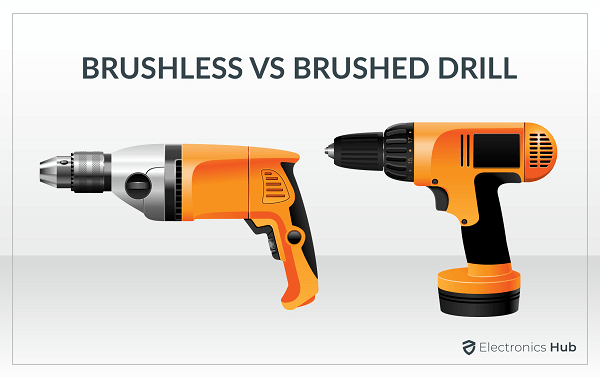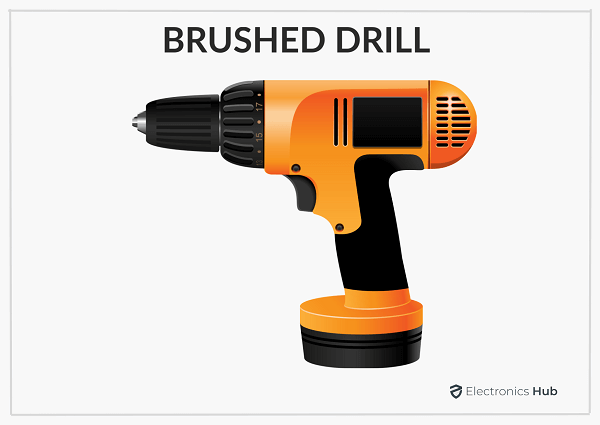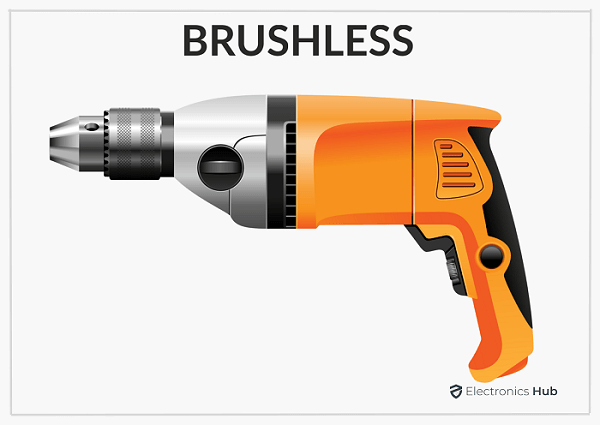If you take a look at the current cordless tools in the market, the brushless variants are dominating. In spite of their dominance, they have a tough competition from brushed counterparts. This is evident in the drill segment where people often assess Brushless vs Brushed Drill when they are purchasing a new drill for the first time or upgrading their old drill.
In this guide, let us explore the world of drills i.e., Brushed and Brushless Drills, list out their advantages and disadvantages, draw a Brushless vs Brushed Drill Comparison chart and figure out which type of drill is best suited for you: Brushless or Brushed.
Outline
ToggleBrushed Vs Brushless Motors

Hence, even though our discussion is related to Brushless vs Brushed Drills, we are essentially going to talk about Brushless and Brushed Motors. Let us begin the discussion starting with Brushed Motors.
Brushed Motors

When we provide DC Power to the armature windings through commutator rings, a magnetic field is induced in the coil according to Lorentz Law. This will make the rotor to rotate.
Spring loaded commutator brushes will help the commutator to make contact with the DC Power Source. Hence, these brushes play an important role in the working of a DC Motor. Commutator Brushes are usually made up of Carbon.
Brushless Motors

One of the main failures of Brushed DC Motors are its brushes. As they are responsible for transmitting the power to the armature winding, they have to continuously make contact with the commutator and as a result you can see sparks and eventual burnout.
In contrast to Brushed Motors, the rotor in Brushless Motors is made up of a permanent magnet while its stator is made up of a series of windings. When we energize the stator coil, a magnetic field is induced in the coil and this attracts the magnet of the rotor. If we have three such windings, we can alternatively energize the coils and make the rotor rotate continuously.
Brushless DC Motors make use of Hall Effect sensors to know the position of the rotor and based on the data from these sensors, an electronic control circuit will activate the appropriate coil (or a set of coils) to have a smooth rotation.
Advantages and Disadvantages of Brushed and Brushless Motors
Now that we have seen a little bit about both these motors, let us weigh the pros and cons of these motors.
Advantages of Brushed Motors
- Brushed Motor technology is a proven technology. Many small DC Motors are of Brushed type. You can find them in toys, small – medium appliances (hair dryers), electric drills and screwdrivers, heat guns, soldering stations, and many more.
- The design and construction Brushed DC Motors is very simple.
- Due to small number of internal components, the manufacturing is easy. This in turn means that the overall cost of brushed DC Motors is low.
- Very wide range of applications: toys, electrical appliances, automobiles.
Disadvantages of Brushed Motors
- The main disadvantage of Brushed DC Motors is in the name itself, the brushes. Brushes are the main source of mechanical failure in Brushed Motors. They continuously make contact with the commutator to transmit power from the supply to the winding. They will wear off eventually.
- Brushes also cause sparks in the motor. Hence, brushed motors are not generally preferred in sensitive areas.
- They are source of electric noise (due to the arcing). EMI Sensitive applications may not entirely use brushed motors or require additional shielding.
Advantages of Brushless Motors
- As they are almost friction free, you can use brushless motors for extended periods without worrying about mechanical losses or failure (except for bearings).
- The problems associated with brushes such as wear-and-tear and excess heat generation are absent in brushless motors. This in turn means that the overall efficiency of the motor is significantly higher.
- Brushless motors are considerably lighter in weight as well as compact in size when compared to brushed motors.
Disadvantages of a Brushless Motor
- Even though they do not have any brushes, the electronic control circuit and sensors make up for the high cost of brushless motors.
- In spite of their friction less operation, any damage to the electronics might result in a costly repair or if it is beyond repair, then you have to completely replace the motor.
Brushed Vs Brushless Motor Comparison Chart
| Parameter | Brushed Motor | Brushless Motor |
| Cost | Low | High |
| Efficiency | 75 – 80% efficiency | 90% or more |
| Size | Large and significantly heavy | Small and light weight |
| Performance | Loses torque over time | Provides high torque for long time |
| Time between failures | Low due to brushes | High due to frictionless working |
| Maintenance | Brushes must be changed frequently | Minimal maintenance |
| Repairability | Very easy to repair/replace brushes | Difficult to repair if problem with electronics |
| Drive Mechanism | Commutator, brush-based friction drive | Electronic frictionless drive |
| Control | Manually adjustable torque and speed | Auto adjusting torque and speed depending on load |
Brushless Vs Brushed Drill
Until the development of Brushless Drills, Brushed Drills are the dominating type on the market both in corded and cordless segment. This trend slowly began to change with the introduction of Brushless Drills with superior brushless motors, especially in the cordless drill market.
Let us now take a look at the Brushless vs Brushed Drill comparison with respect to some essential parameters such as power, performance, cost etc.
Power
Brushed Drills are less powerful than brushless counterparts. As the power in brushed drills must pass through brushes, there will be a significant loss due to friction and heat. Brushless Drills on the other hand doesn’t have any frictional losses. As a result, they can achieve very high RPM (in the order of 50,000 RPM or higher) easily.
Performance
This again is dependent on the power of the drills. Brushed Drills have a low power to torque ratio. This ratio falls down further with continuous usage as brushes wear out and eventually must be replaced. Brushes need to make physical contact with the commutator rings at all times. This will have a significant impact on the drive torque. Brushless Drills have no frictional losses. Hence, the torque losses are very minimum and this in turn means a good power to torque ratio.
Lifespan and Maintenance
Once again, brushes come into action. Due to the physical wearing of the brushes, they must be replaced quite often. Good thing about most of these brushed drills is that their construction is very simple and with slight practise you can easily replace the brushes yourself. Brushless Drills doesn’t have any physical wear and tear but the problems could arise in the form of electronics. Sadly, it is difficult to diagnose the error and also expensive to repair.
Depending on the usage, the life time of brushed drills is very low before the brushed give up and must be replaced. In contrast, brushless drills have a significantly higher life time.
Usability
Brushed Drills are heavy and loud. Your shoulders and back take a significant toll if you have to use it for a longer period with hearing protection. Brushless Drills win in this context. They are light in weight and are relatively quiet. As a matter of fact, the lightweight and less noise is one of main selling point of brushless drills.
Cost
Coming to the final and important factor: the price. Good Cordless Brushed Drills cost anywhere between $60 to $80. But if you go to Brushless options, you have to spend $150 or even more. Hence, depending on your requirement, you might have to choose between Brushed or Brushless Drills.
Which Drill to Choose? Brushless or Brushed
If you are a professional who works with drills all the time, then investing in brushless drills will save you a lot in the longer run. You don’t have to worry about heat and wearing of brushes and use the brushless drill for a long duration. But due to their lightweight and low noise, even home owners, who don’t use drills that often, are spending that extra money to buy brushless drills. If budget is your constraint and you use drill very rarely, then you are better off with a brushed drill. You will save a lot of money and even if you have to replace the brushes, you can easily repair them on your own.
Conclusion
Brushless vs Brushed Drill is a long running dilemma among drill buyers. Brushless Motor based Drills have many advantages over the Brushed Motor Drills but the cost is one of the main disadvantages. Cordless Brushless Drills are light in weight, make less noise, requires almost no maintenance and have better power efficiency. As a result, more manufacturers are pushing Brushless Drills even in the entry and semi-professional categories.


One Response
Well explained. Good work